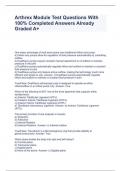Other
SUMMARISED OCR A-Level Biology Module 6 Notes based on Mark Schemes
These notes got me an A* in OCR A-Level Biology. These notes were made to be bite-sized and straight to the point. Best part? They incorporate MARK SCHEMES answers (in blue) from previous OCR past paper questions so you can get an exact idea of what the exam wants from you. There's also a column fo...
[Show more]












